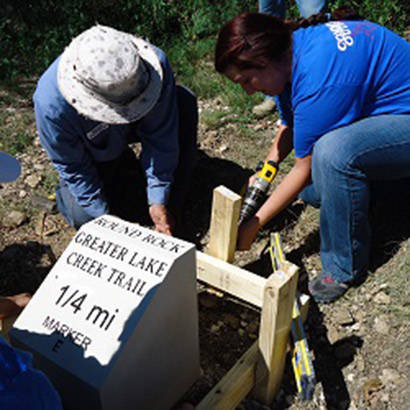
“People love walking or running up and down the Brushy Creek Corridor,” Round Rock Parks and Recreation director Rick Atkins states. “You’re always sure to find an Indian arrowhead or something distinctive just by kicking the dirt and walking around and getting close to the water.” Through improvements funded by a Great American Trails grant award, residents can explore the archaeological treasure trove of that corridor—and get to know their neighbors—more safely and knowledgeably.
Round Rock is a place rich in history, natural landmarks, and local pride. The region’s creeks marked the settlements of ancient Native Americans, and the city’s founding is rooted in the historic Chisholm Trail of cattle-drive fame. Yet, despite the importance of trails to the community, Round Rock’s trails have lacked connectivity and adequate signage. So, the city committed to working, one trail section at a time, toward a connected five-to-six-mile loop. The 1.5-mile section targeted for the Great American Trails project offered the perfect opportunity to establish signage that the parks and recreation department would continue throughout the trail system.
The 20 trail markers funded by the grant, set at quarter-mile intervals, provide both directional and interpretive guidance for trail users, and, if a hiker is injured, the markers make it easy to provide a reference point when calling for help.
Additionally, the stone trail entrance columns with comprehensive trails maps—along with directional and educational signage at trail heads—offer not only directional guidance but insights into local landmarks and the history of the Brushy Creek area. The rounded rock formation for which the city was named, for example—a feature clearly visible from the trail—served as a gathering place for the region’s earliest settlers. “The history is very rich, and our community knows it,” Atkins remarks. “And we want to offer them information about that heritage.”
The park director adds that local Longhorn Steakhouse employees participated actively in the project, participating in planning discussions and turning out for a workday to install 40 concrete markers. Atkins describes the work with the LongHorn volunteers as an example of cheerful, wholehearted cooperation. The restaurant employees, with their positive, can-do attitude, he says, offered their time and labor with a spirit of excitement about improving the community. And their enthusiasm proved contagious for the parks and recreation workers.
LongHorn Steakhouse Managing Partner Chuck Gilbert says the markers he and 18 employees installed were only the beginning of the local restaurant’s commitment to the Round Rock trails project. He says they plan to add to the signage, marking trail entrance points. And, he adds, he and his staff have committed to keeping up the aesthetic value of these trails by providing continuing assistance.
While the trail improvements enhance access to local history and natural wonders, they also counteract the fragmenting effects of residential subdivisions. As Atkins comments, “Our communities basically go from neighborhood to neighborhood; trails give you the ability to bridge gaps and unite five or six neighborhoods within a small amount of space.”
“Trails,” he concludes, “take a large city and they make it smaller,”
